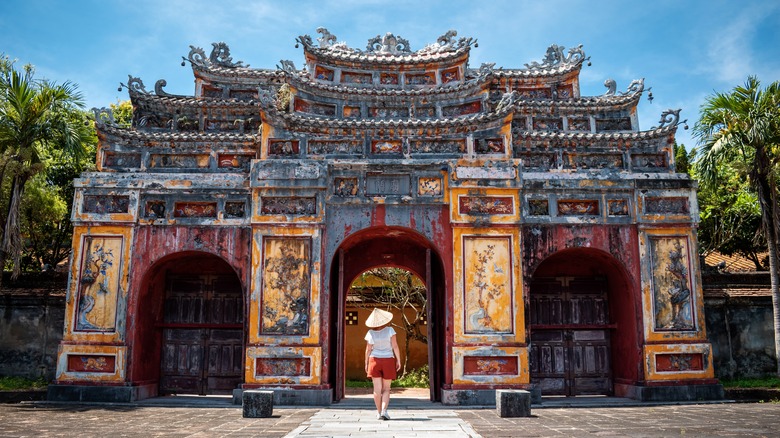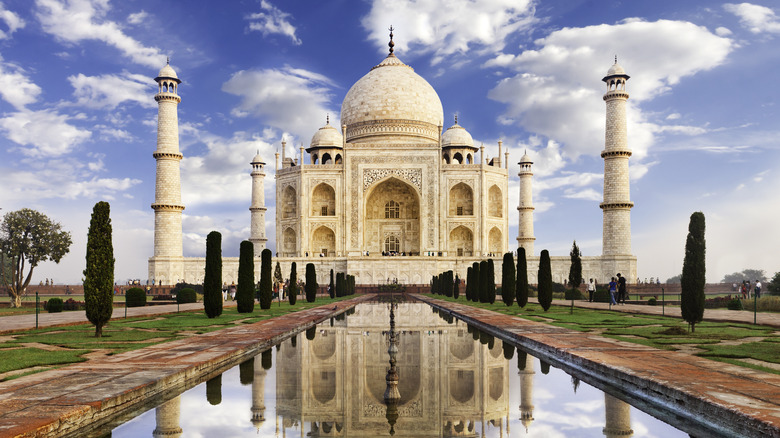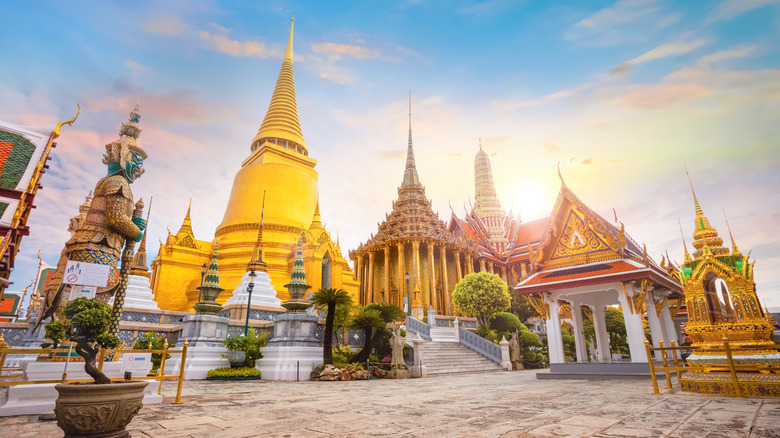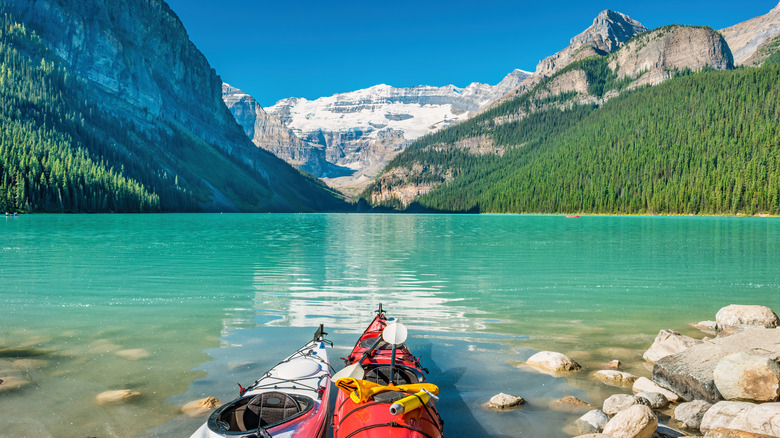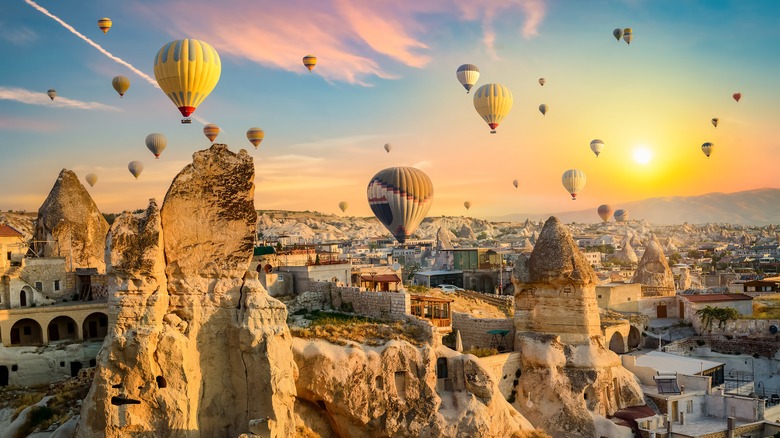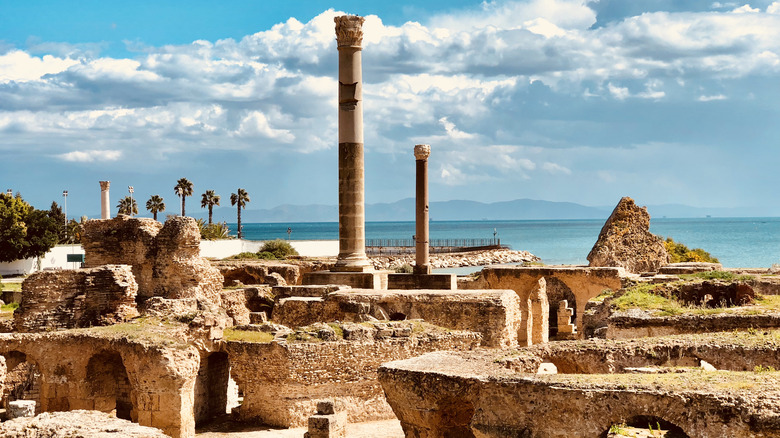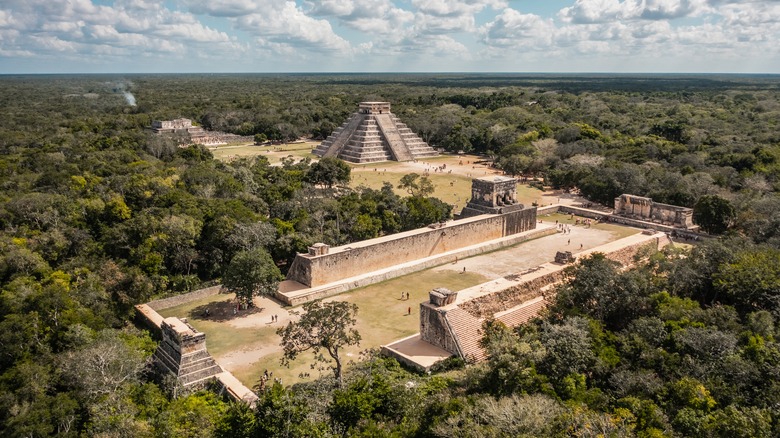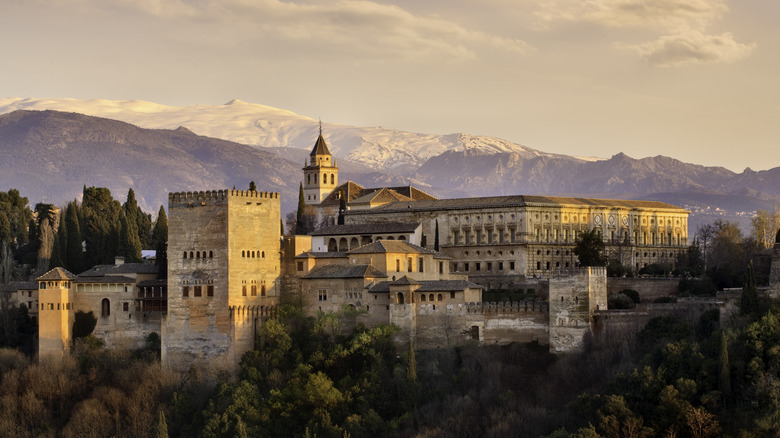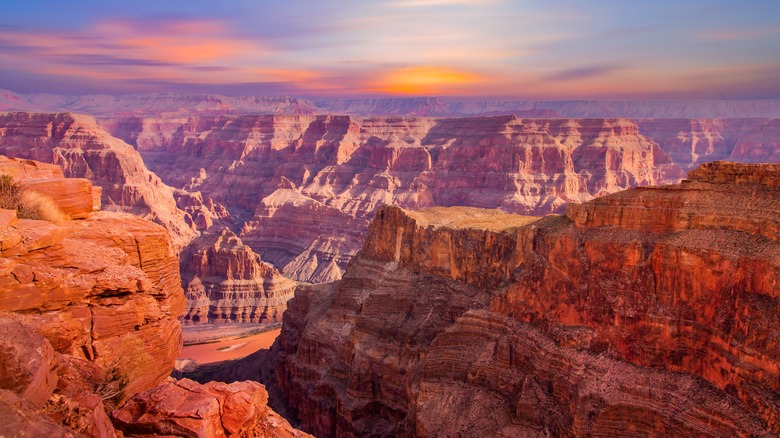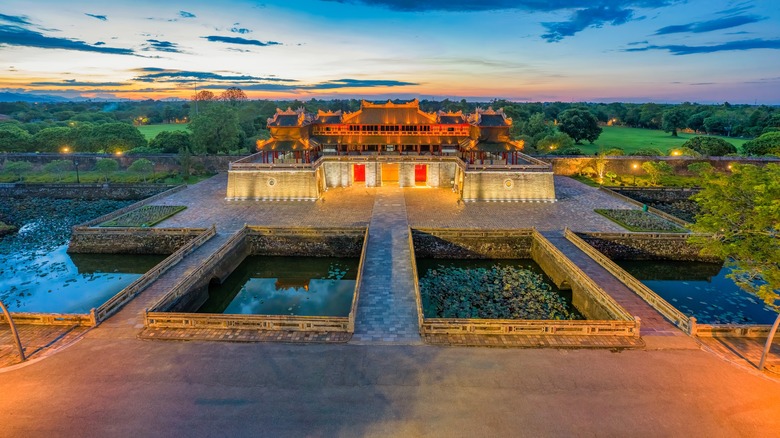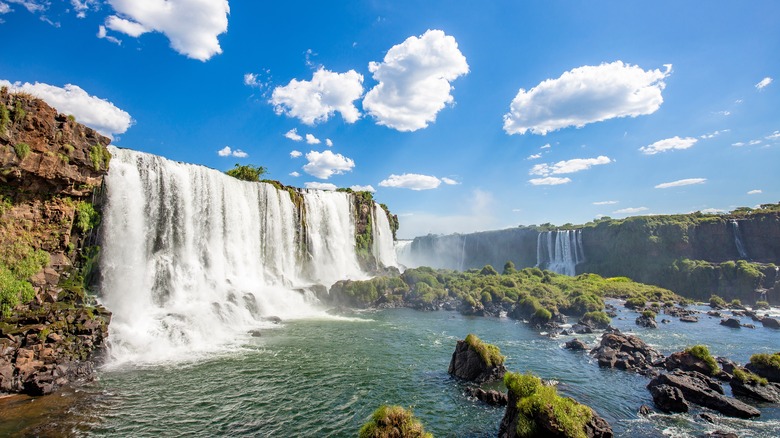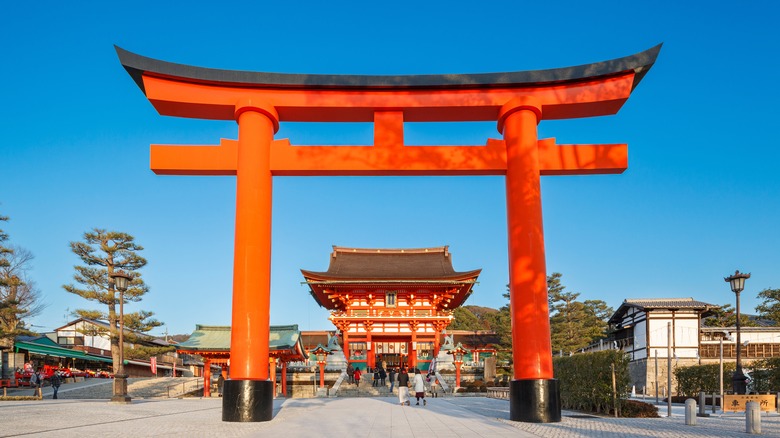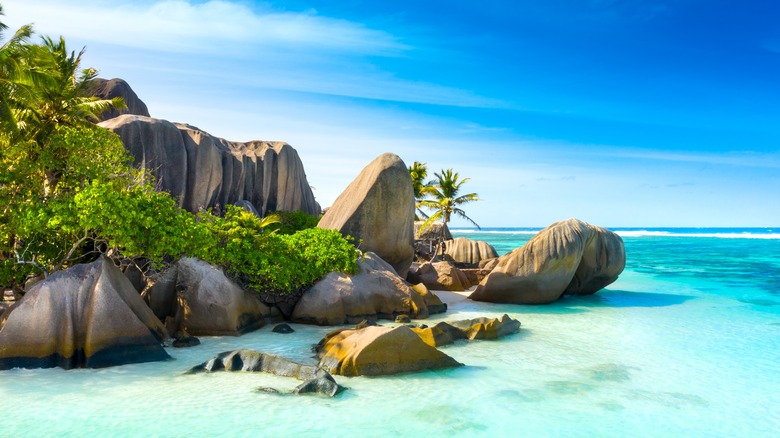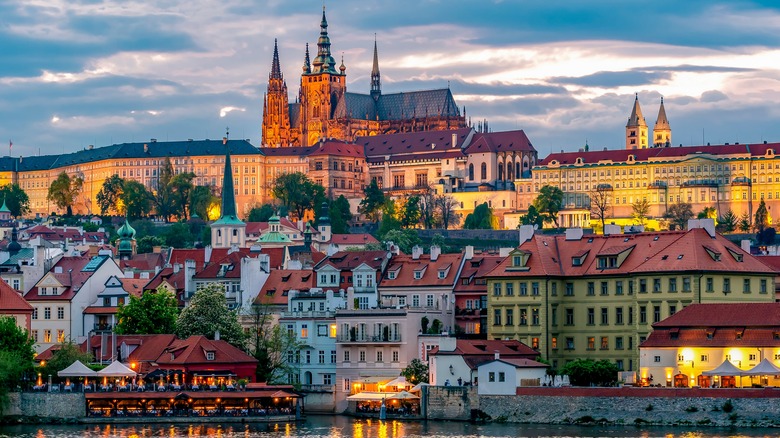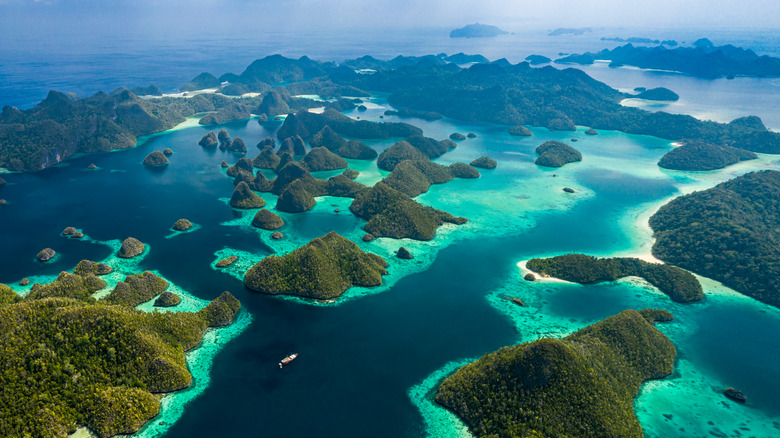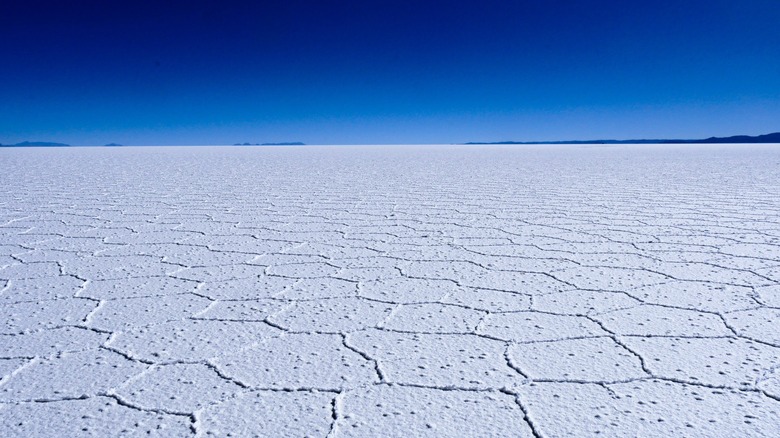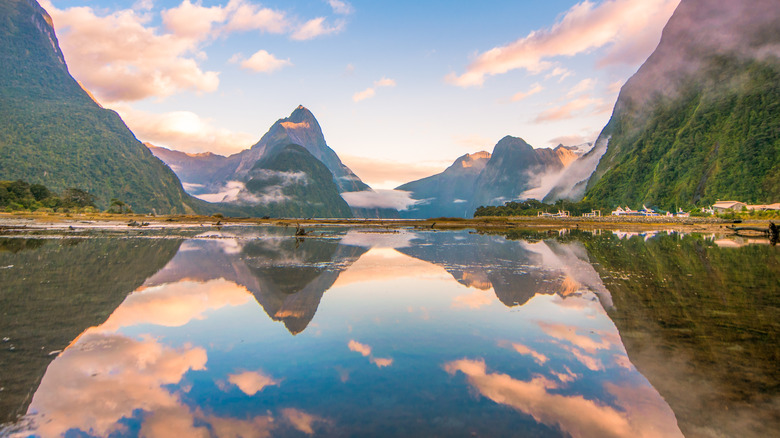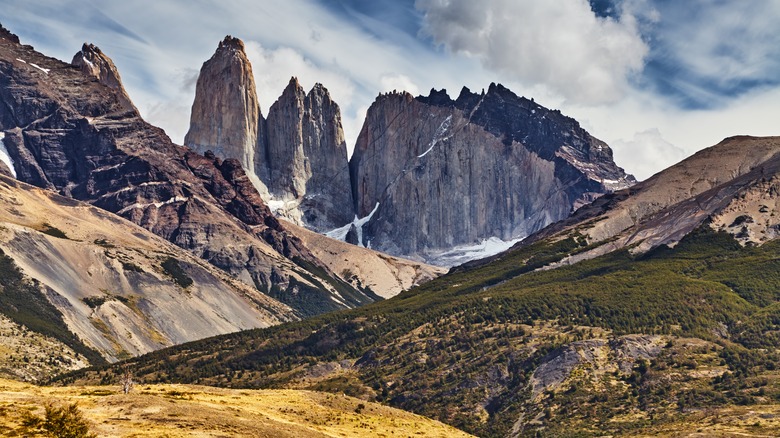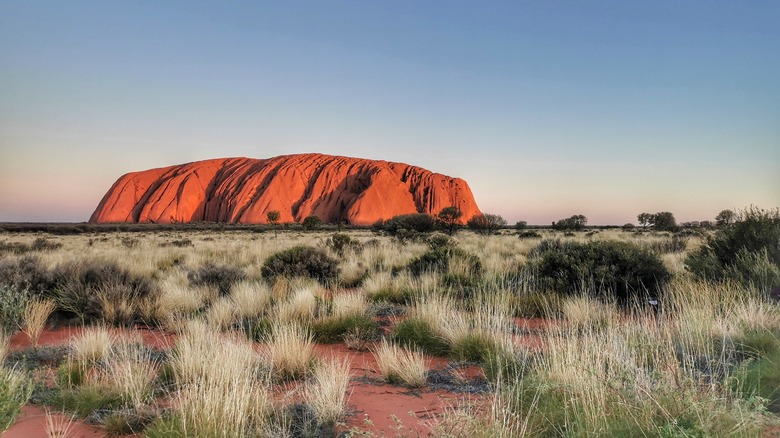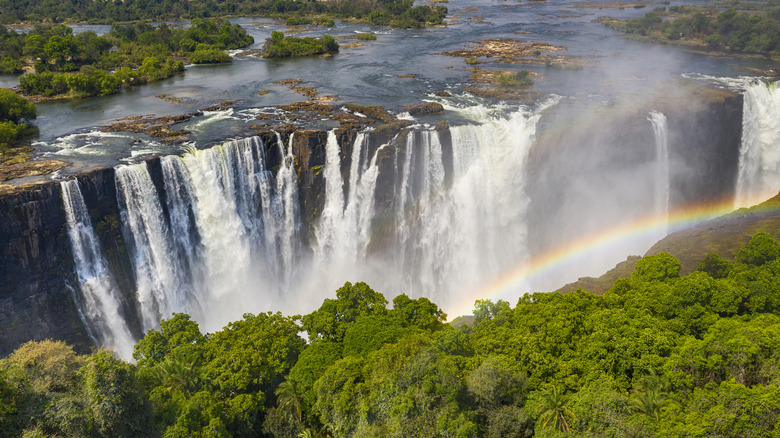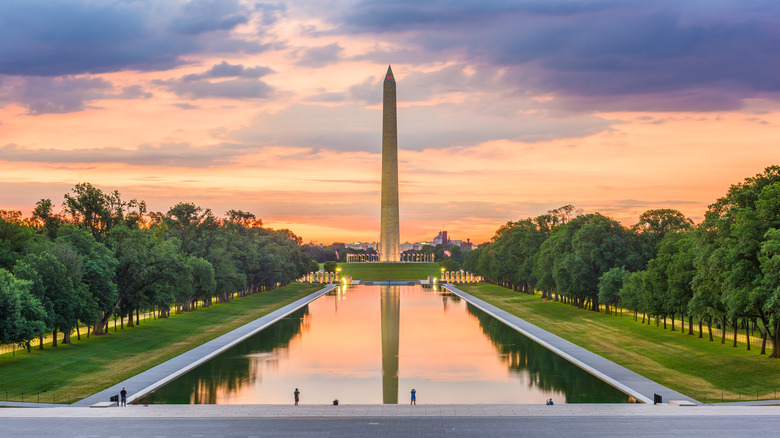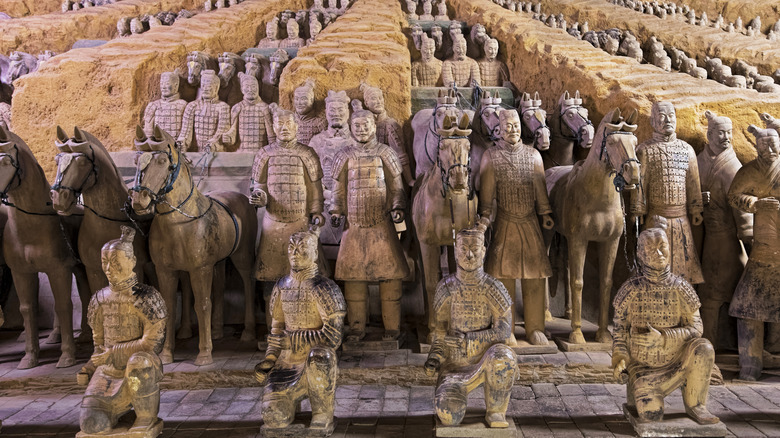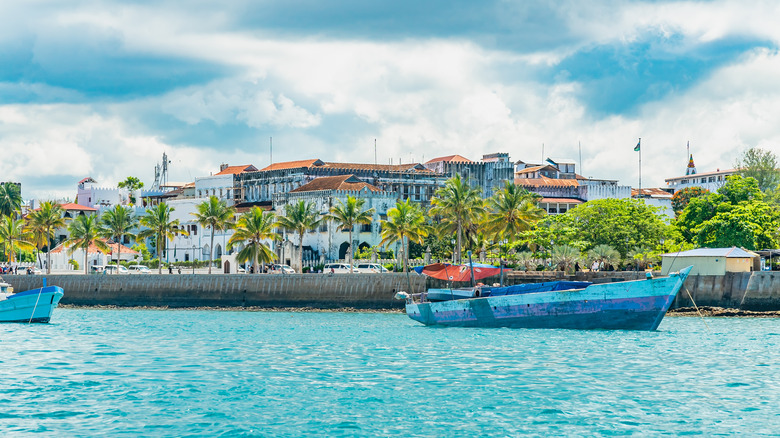Once-In-A-Lifetime Vacation Destinations You Don't Want To Miss Out On
The world is a big place, and even as the global travel network grows, development driven by a rising population ramps up, and technological advances make it more accessible, there are still destinations waiting to be discovered and explored. Then there are also well-known places whose reputations have grown to such an extent that they have entered the realm of the hallowed, discussed in terms of hushed, or gushing, awe.
Some are shaped by nature, others created through the relentless vision of humankind, but they all hold a special place for anyone who loves to travel. Our list of once-in-a-lifetime vacation destinations isn't exhaustive — no list could ever be — but has been carefully compiled based on our personal experience, travel blogs, and a healthy dose of armchair travel wanderlust. For any jet-setters who pride themselves on hitting sites that they will never forget, the compendium that follows certainly checks all the boxes.
Agra, India
This city southeast of Delhi might not come with instant name recognition, but almost everyone knows about the Taj Mahal. Located in Agra, this shrine was built in the 1600s by Mughal emperor Shah Jahan for his beloved wife Mumtaz Mahal, who died shortly after giving birth to their 14th child.
The structure is a vision, a rhapsody in ivory-white, with precision geometry and gleaming marble and peppered with inscriptions, precious stones, and fine details. Words, though, will never do the Taj Mahal real justice. Visitors should see the building around dawn or dusk, times when the light lends it a magical, otherworldly aura.
Hiring a guide is also a great idea so you can soak in many historical facts about the stunning mausoleum. While the Taj Mahal is perhaps the most famous building in the whole of India, the city is also home to the stunning Agra Fort, a dream of red sandstone also built in the era of the Mughal Dynasty.
Bangkok, Thailand
The Thai capital is one of those destinations that just draws you in, almost imperceptibly, and stays with you forever. It is modern and ancient, slow and breakneck fast, a teeming metropolis with vivid urban life and tranquil temples, surging markets, and a serene river.
One glittering stop is the Grand Palace, a vast compound surrounded by high walls featuring halls, residences, and a temple. The opulence is outrageously seductive — from the gilt tops of stupas and accents on buildings to the precious stones on statues and even a Buddha made from emerald. The photo opportunities are endless.
Bangkok also has shiny malls all over the city, but the night markets are the real draw, dotted in all corners and packed with stalls selling anything and everything. And when it's time for some sustenance, the street food is scintillating, especially the stalls around the Chinatown district of Yaowarat.
Canadian Rockies, Canada
For lovers of the mountain life, nowhere in North America compares. The Rocky Mountains are a chain that extends for thousands of miles as they slice through the west of Canada and the United States. While their coverage is greater in the United States, the Canadian section of them seems to be more exciting — more varied in texture and visual enchantment.
They are also much quieter, with fewer visitors than in the United States, so for that sense of solitude that many travelers seek, Canada is the smart choice. The Canadian Rockies appear more wild, rugged, and craggy, with glacial activity evident.
The sharp shapes and baby blue glacial lakes make this such a mesmerizing natural destination. Cast your eyes on places like Lake Louise, Emerald Lake, and Peyto Lake, especially on a winter morning with snowy peaks as a backdrop, and you might wonder how anything could ever be so stunning.
Cappadocia, Turkey
The way rock formations curve and rise in this region, as if sculpted like giant drips of candle wax, makes Cappadocia, Turkey such a bucket-list destination. The landscapes here look almost as if they were created for a movie set, and yet they are very much real. The fairy chimneys and eroded basalt that look like giant toadstools could be a home for creatures from a fantasy tale, while churches and caves built into the rock, where people once lived, transport visitors back to a distant era.
There are even complete cities dug underground, like something out of a dystopian novel. Some have likened the contours of Cappadocia to those of the moon, and the area does feel alien at times. But it's all the more hypnotic for it, and visitors will never forget the sight of the terrain when taking a balloon ride over it — they are extremely popular and easy to arrange.
Carthage, Tunisia
Look at a map of the world and zoom in on the southern Mediterranean, where Europe and North Africa almost touch. Tunisia and the Italian island of Sicily are separated by a narrow strait, which might help to explain why Tunisia is home to some of the finest Roman ruins in the world. Particularly remarkable are those in Carthage, at the edge of the capital Tunis.
Carthage has a long history, settled by the Phoenicians before being plundered and recast by the Romans, and the archaeological past is now of such historic importance that it is a UNESCO World Heritage Site. Sitting on a hill overlooking an ancient port, the complex retains much of its original forms and includes an acropolis, old settlements, a burial site, and a museum. After exploring history, travelers can enjoy the charming blue and white buildings of the nearby seaside village of Sidi Bou Said.
Chichén Itzá, Mexico
The Maya were a thriving civilization that lived for thousands of years in what is now Central America. Evidence of their planning, ingenuity, and organizational prowess is evident at sites throughout Mexico, Guatemala, Belize, and Honduras, but some of the most incredible ruins are found in Chichén Itzá. A grand network with many sets of ruins, it is easily reached from the tourist hub of Cancún, a few hours drive away.
This is a popular place, with more than 2 million visitors a year, and for good reason. Chichén Itzá was voted a New Seven Wonder of the World in 2007, and the pyramids, temples, and areas where the Maya would play games are in incredible shape. Visitors can study buildings that date back 1,500 years, and since the restorations are so good, it's easy to picture this complex as a living, breathing metropolis where thousands of people rode out their daily existence.
Granada, Spain
A city in southern Spain, Granada oozes with a richly varied history, evidenced by its striking buildings. It's also quite magnificently positioned, sitting by the Sierra Nevada range and flanked by a pair of rivers. On a winter's day, looking over the cityscape, with snow-capped mountains behind, is a heart-warming sight. The imprint of the Moors — people who came from North Africa and governed much of Spain for centuries — is all over Granada, most famously in the El Albaicín district and at the Alhambra.
The former has tight alleys and grand gates, or puertas. Nearby, the Alhambra, a palace with striking buildings, stunning gardens, and sumptuous courtyards, is one of the most memorable pieces of architecture on the planet. Next door, the Generalife has gardens to make the heart weep with joy, while the city's Catholic influence is visible at the grand, Renaissance-style Cathedral of Granada, where the white interiors are, literally, dazzling.
Grand Canyon, United States
Nature calls to us at many places in the U.S., from the roar of Niagara Falls to the irresistible hoodoos at Bryce Canyon National Park. But the colors and shadows of the Grand Canyon are endlessly hypnotic and might just top them all. Slowly, patiently shaped by the forces of water on rock, the Grand Canyon is an eternity in the making.
Somewhere between 30 and 70 million years ago, shifting tectonic plates pushed up the region, and then, eventually, the Colorado River began to make its passage through the area in any way it could, cutting a canyon as it pushed forward. Look at the canyon's sides, and the layers of rock, each representing different periods of history, are plain to see. The reds, pinks, rusts, and browns of the mineral-rich strata are like a painting come to life. Looking across the colossal canyon is a humbling experience, which is a good exercise for everyone.
Hue, Vietnam
The setting of this former imperial capital is enough to set the heart aflutter. Hue sits a little inland from Vietnam's S-shaped coastline, in the center of the country, and flanks the Perfume River (what a name!). The historic part hugs the northern bank of the river, and its architecture is ravishing, from the scope of the complex to the fine workmanship required to put it together.
Visitors can wander around the imperial city, which was placed by mountains to keep evil spirits away and see buildings with sweeping tiled roofs, pavilions and palaces, and theaters that were hubs of performing arts. But the citadel, where the city was located, also served as a military stronghold, and travelers can marvel at the towering, sturdy defensive walls with moats behind them. Elsewhere in Hue, many dynastic emperors are buried in tombs near the citadel, and visiting them is equally edifying.
Iguazu Falls, Argentina/Brazil
This might not be the tallest waterfall in the world (that's in Venezuela), but for sheer grandeur of scope, Iguazu Falls is hard to beat. The falls aren't singular, but hundreds of them make up this series of cascades that straddle the borders of Argentina and Brazil, producing a truly mouthwatering spectacle. The word Iguazu, which also refers to the river that feeds the falls, comes from a local indigenous term that translates to "great water."
The name is accurate, and visitors might find it hard to comprehend the scale of this natural phenomenon — the falls form a U-shape and extend for almost two miles. The water drops anywhere from 200 feet and up, depending on the individual cascade, but the sheer quantity of drops makes the entity all the more impressive. National parks on both sides of the falls are also rife with wildlife, including jaguars, tapir, and many birds.
Kyoto, Japan
Another imperial capital, Kyoto provides travelers with a deep dive into the history of Japan, and, more simply, it's just a gorgeous city. Tradition courses through the streets, reflected in the many temples dotted throughout Kyoto, like the incredibly vibrant Fushimi Inari Shrine, with its thousands of red-orange gates.
A trip here wouldn't be complete without time at Kinkakuji Temple. Its Golden Pavilion that sits atop a still lake — the reflections are spellbinding, especially on a fall day when the foliage seems to set the scenery ablaze — is the focal point, while the grounds are a joy to wander.
Kiyomizudera Temple is notable as much for its fine form as its location, on a hill above the city that comes with striking skyline views. Another place ideal for moments of reflection is Arashiyama, on the outskirts of Kyoto; its bamboo groves feel like an enchanted realm, an escape from the world.
La Digue, Seychelles
Who can resist a good beach, the soft sand that feels so nourishing and supporting underfoot, the gentle lilt of the water as it ebbs and flows, the sensation of carefree liberation from the strictures of daily life? We all have our favorite beaches, the ones that we yearn to go back to over and over again, but how many of them can claim to be, possibly, one of the best beaches in the world?
On La Digue, one of the 115 islands that make up the small Indian Ocean nation of Seychelles, visitors will find a beach that will make the average curling sweep of sand seem plain blah. Here, on the waterfront at Anse Source d'Argent, travelers can find giant weathered granite boulders that look like they belong in the era of dinosaurs, brilliant white sand with grains like sugar, and water that is as clear as the setting deserves.
Prague, Czech Republic
For fans of old and new architecture and everything in between, the capital of the Czech Republic is a living, breathing museum. The variety across the city is dazzling, from the chunky towers and walls of the Romanesque era to the pointed spires of the Gothic vernacular; from the aristocratic flourishes of Baroque and Rococo to the blunt utilitarianism of the Communist era.
Sometimes, walking around Prague, you might look up and feel as though the scene before you has been lifted from the pages of an ancient fairy tale. Hotel Paris showcases the Art Nouveau influence here, while the sandstone Charles Bridge, one of the most famous and photographed spots in the city, places the Gothic era firmly in focus. One building not to miss is Prague Castle, a vast complex that can easily take a day to explore and that has a cathedral, royal palace, and a gallery within.
Raja Ampat, Indonesia
Divers usually have a list of places that they dream about, locations peppered around the globe that are spoken of in tones of awe or mentioned with lashings of envy. Near the top of that list, inevitably, is Raja Ampat, which means "Four Kings" in Bahasa Indonesian, a remote archipelago in the east of Indonesia where the seascapes defy belief; and it is one of the best and the snorkeling and diving destinations.
Its name derives from an old legend, where eggs hatched, and the four of the spawn become kings of islands, and while the story is certainly fascinating, the scenery here really is legendary. Picture small, hilly islands covered in rainforests, rising like small creatures from a sea whose clarity and colors are hard to comprehend. Then there is the life underwater, with more than 500 varieties of coral, thousands of fish, and about 75% of the world's marine species here.
Salar de Uyuni, Bolivia
Unless you're willing to hand over hundreds of thousands of dollars to hop on a rocket and escape Earth's atmosphere, traveling into space isn't a reality. But head to the south of Bolivia, near the borders with Chile and Argentina, and you could easily believe that you've landed on the moon. This endless plain of salt, known as Uyuni Salt Flat in English, is the biggest on the planet, covering more than 3,000 square miles. It sits on an elevated plateau, formed when the Andes were pushed up by tectonic forces, and is the remnant of ancient lakes whose water evaporated.
Today, this landscape offers so many photographic opportunities, from spare, barren terrain to flats that, when covered with a thin layer of water, seem like a mirror that extends to the horizon. There are also lakes with water of various hues (thanks to the minerals), eerie rock formations, hot springs, and ghost towns.
Southland, New Zealand
This region of New Zealand sits in the south of the country, at the bottom part of the South Island. That sense of extremity, of the edge of the earth, is handsomely supported by the climactic scenery because Southland is home to some of the most dramatic landscapes in a country that is already known for its natural pomp. This is the land of vast fjords shrouded in misty forest, waterfalls crashing down rock faces, and cruises that bring you close to it all.
Milford Sound is the most epic destination, a mammoth fjord created by glacial movements and that still feels untamed. Hikers can get a more personal view of this astounding terrain by booking a spot on the incredible hikes here. Among them is the Milford Track — arguably the most famous hike in the Southern Hemisphere, if not the world — which takes in mirror-like lakes, long valley vistas, and jagged mountains.
Torres del Paine National Park, Chile
Another area of extreme natural beauty, this park in Chila's Patagonia is a realm of jagged mountains and alpine lakes. Some of the landscapes are so perfectly composed that, seeing them, you might feel that you are in a dream. But this place is very real, with its origins going back millions of years when sediment was lifted before being eroded by glaciers. What remained was the craggy, granite peaks visible today.
The three towers of Torres del Paine are the most notorious peaks, but there is much more to see, from the tallest mountain of Cerro Paine Grande (it rises almost 3,000 meters above sea level) to Cerro Catedral, which looks like a shark's tooth. But the mountains aren't all that dazzle visitors, with glaciers, ice fields, rivers, and clear alpine lakes making this place beyond beautiful and bucket-list worthy.
Uluru (Ayers Rock), Australia
Upon seeing Uluru, or Ayers Rock — the former is the Aboriginal name, and the latter is European — travelers are likely to wonder how this monumental slab of rock came to be. A mammoth slab of arkose, it rises from vast plains and looks like a rust-colored iceberg stranded in a sea of scrubby green. Geology explains that this red wonder, located roughly in the center of Australia, formed through processes of erosion and tectonic upheaval, and its distinctive hue comes from the iron in the rock interacting with water and oxygen.
The rock is huge, climbing more than 1,000 feet from the flat surroundings, but it also has deep cultural weight. The Anangu, the Aboriginal population, view Uluru as an intangible dimension where memories merge with the land, inhabiting the same space. Gazing at Uluru during sunset, you might just feel transported to another realm.
Victoria Falls, Zambia/Zimbabwe
The local name of this waterfall that straddles the borders of Zimbabwe and Zambia in southern Africa hints at the power of the cascade. The Kalolo-Lozi people dubbed it Mosi-oa-Tunya, or "the smoke that thunders," a reference to the smoke-like spray and deep roaring sound that the falls produce. This is, by some metrics, the largest waterfall on Earth, more than a mile in length and dropping over 300 feet.
Since the spectacle is dependent on the fullness of the Zambezi River, visitors should time their trip for February to May, after the rains, when the cascades produce dense, swollen torrents of water. Later in the year, around October, the falls are nowhere near as impressive. The sound of Victoria Falls in full flow is unforgettable, like the heaviest rainfall you'll ever hear, backed by the deep growl of a jet engine — but the sight of it will leave you speechless.
Washington, D.C., United States
The capital of the United States has so much for travelers to experience, from iconic buildings to world-class museums, and is supported by an efficient, reliable public transit network. While the White House might be the most famous structure in the city, the National Mall is the capital's beating heart, a verdant public space bordered by institutions that the public enjoys.
Its popularity is evident from the throngs that visit each year, here to see the soaring Washington Monument, the U.S. Capitol, or Lincoln Memorial, all stand-out structures in their own right. And then there are the scores of museums that flank the park, world-class institutions that are, in many cases, free to visit. Many fall under the umbrella of the Smithsonian Institution and include the National Air and Space Museum, the Natural History Museum, and the African American History & Culture Museum.
Xi'an, China
This city in China marked the beginning of the Silk Road, an ancient trading route that stretched for thousands of miles between Asia and Europe. More than 1,000 years ago, Xi'an was the biggest city in the world, and vestiges of its grand stature and influence are evident from the temples, imperial buildings, and fortified walls. But the most exciting sight here is the Terracotta Warriors.
Discovered in 1974 by a farmer, they are life-size replicas of soldiers buried in the tomb of China's first emperor, Qin Shi Huangdi, who ruled in 221 BC. The statues were arranged in large subterranean chambers, or pits, with wooden ceilings and wooden supports to stop them from caving in. They number in the thousands, with wood chariots and terracotta horses also discovered. The scope of the project is phenomenal, but the detailing of each statue is even more momentous.
Zanzibar, Tanzania
On this island off the coast of Tanzania, travelers will come across delightful beaches. From active Nungwi Beach in the north, with its resorts and stunning sunsets, to the calm, picturesque Pongwe Beach, which has great snorkeling, there are choices for everyone. But Zanzibar differs from many other Indian Ocean idylls thanks to its variety of cultural influences.
Stone Town sits on a cape that sticks out of the west of the island, making it a natural point for ships to access. That helped it to become a Swahili trading entrepôt, and the imprint of East African, Arab, European, and Indian cultures soon began to forge the local identity.
The architecture reflects this, from the buildings made of timber and ancient coral, with courtyards, verandas, slender facades, and elaborate interiors pulling on the various cultures. Visitors will find cathedrals, palaces, museums, and Persian baths.
Our methodology
We started this list of once-in-a-lifetime travel destinations by pulling on our personal experience of places that we've visited and will never forget. This was backed up by destinations that we've always dreamed about seeing, as well as content from travel blogs. We made sure to put together options that ensured a healthy geographical spread so that wherever you are, you'll find something extraordinary in your part of the world.
